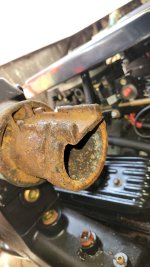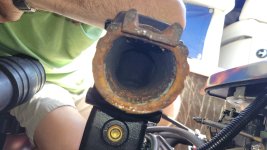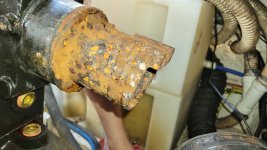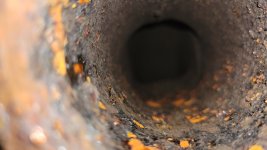jakwi
Petty Officer 2nd Class
- Joined
- Jan 7, 2019
- Messages
- 184
Hi all,
Well I pulled together the cash to purchase the OEM manifolds, 3 inch spacer and the riser/elbows. I couldn't quite swing the dry joint option, so what I purchased are the E coated wet joint parts. $1036 shipped, which was the most affordable option I found for OEM parts. Thanks to everyone that has answered my previous questions, and helped me figure this out.
Anyway I have a few questions. I've reviewed the manual but it is a little vague on a couple of things.
The torque specs I have are 25lbs for the risers, and 33 lbs for the manifolds
I'm not sure if the 25lb number is valid for 3 inch spacer studs though.
Further I'm a little unsure of the process for installing the studs that secure the risers.
How about anti seize? I've read about using anti seize, and also that some recommend marine grease instead. Should it be used on all threaded joints? risers nuts, spacer studs, and Exhaust manifold bolts?
The parts kit I purchased doesn't come with exhaust manifold bolts, I have seen where I can purchase the specified bolts for about $3 each. Is there any reason I can't go to a local nut and bolt place and buy grade 5 bolts? They would certainly be cheaper than $3 each.
Is there a preferred sequence for torquing? How about stepped torques?
Finally what is the best process?
Manifold then riser and elbows, then run to temp, and retorque while hot?, or maybe cold.
How many heat cycles before I can be confident in the torque?
How can you be sure it isn't leaking if the only way to know is to take it apart?
Thanks again for all of the help
Well I pulled together the cash to purchase the OEM manifolds, 3 inch spacer and the riser/elbows. I couldn't quite swing the dry joint option, so what I purchased are the E coated wet joint parts. $1036 shipped, which was the most affordable option I found for OEM parts. Thanks to everyone that has answered my previous questions, and helped me figure this out.
Anyway I have a few questions. I've reviewed the manual but it is a little vague on a couple of things.
The torque specs I have are 25lbs for the risers, and 33 lbs for the manifolds
I'm not sure if the 25lb number is valid for 3 inch spacer studs though.
Further I'm a little unsure of the process for installing the studs that secure the risers.
Should I just spin them in finger tight and then torque the nuts on top, or tighten the studs in with vice grips and then torque the nuts?
How about anti seize? I've read about using anti seize, and also that some recommend marine grease instead. Should it be used on all threaded joints? risers nuts, spacer studs, and Exhaust manifold bolts?
The parts kit I purchased doesn't come with exhaust manifold bolts, I have seen where I can purchase the specified bolts for about $3 each. Is there any reason I can't go to a local nut and bolt place and buy grade 5 bolts? They would certainly be cheaper than $3 each.
Is there a preferred sequence for torquing? How about stepped torques?
Finally what is the best process?
Manifold then riser and elbows, then run to temp, and retorque while hot?, or maybe cold.
How many heat cycles before I can be confident in the torque?
How can you be sure it isn't leaking if the only way to know is to take it apart?
Thanks again for all of the help























